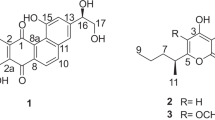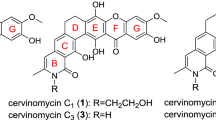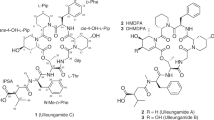Abstract
A new cytotoxic agent designated as 2-epi-anthracimycin (1) was isolated along with anthracimycin and anthracimycin B (2-demethylanthracimycin) from the culture broth of the marine-derived actinomycete Streptomyces sp. OPMA00631. The structure of 1 was elucidated based on spectroscopic analyses (1D and 2D NMR data and ROESY correlations). Compound 1 exhibited cytotoxicity against Jurkat cells with an IC50 value of 50.5 μM in 20 h. The effect of 1 on the cell cycle distribution of Jurkat cells was investigated. Compound 1 (7.80 μM) increased G1 phase cells from 51.1 to 62.0% and conversely, decreased G2 and M phase cells from 30.7 to 19.3 % in 20 h. At a higher concentration, 1 (250 μM) markedly increased subG1 phase cells (1.9% at 0 h to 16.5% at 20 h), while the proportion of G1 phase cells was maintained (62.3%). These results suggest that 1 exhibits cytotoxicity against Jurkat cells by arresting the cell cycle at the G1 phase.
This is a preview of subscription content, access via your institution
Access options
Subscribe to this journal
Receive 12 print issues and online access
$259.00 per year
only $21.58 per issue
Buy this article
- Purchase on Springer Link
- Instant access to full article PDF
Prices may be subject to local taxes which are calculated during checkout




Similar content being viewed by others
References
Kang HK, Seo CH, Park Y. Marine peptides and their anti-infective activities. Mar Drugs. 2015;13:618–54.
Newman DJ, Cragg GM. Natural products as sources of new drugs over the 30 years from 1981 to 2010. J Nat Prod. 2012;75:311–35.
Debbab A, Aly AH, Lin WH, Proksch P. Bioactive compounds from marine bacteria and fungi. Microb Biotechnol. 2010;3:544–63.
Trzoss L, Fukuda T, Costa-Lotufo LV, Jimenez P, La Clair JJ, Fenical W. Seriniquinone, a selective anticancer agent, induces cell death by autophagocytosis, targeting the cancer-protective protein dermcidin. Proc Natl Acad Sci USA. 2014;111:14687–92.
Fukuda T, Takahashi M, Kasai H, Nagai K, Tomoda H. Chlokamycin, a new chloride from the marine-derived Streptomyces sp. MA2-12. Nat Prod Com. 2017;12:1223–6.
Fukuda T, Takahashi M, Nagai K, Harunari E, Imada C, Tomoda H. Isomethoxyneihumicin, a new cytotoxic agent produced by marine Nocardiopsis alba KM6-1. J Antibiot. 2017;70:590–4.
Fukuda T, Shinkai M, Sasaki E, Nagai K, Kurihara Y, Kanamoto A, et al. Graphiumins, new thiodiketopiperazines from the marine-derived fungus Graphium sp. OPMF00224. J Antibiot. 2015;68:620–7.
Jang KH, Nam SJ, Locke JB, Kauffman CA, Beatty DS, Paul LA, et al. Anthracimycin, a potent anthrax antibitotic from a marine-derived actinomycete. Angew Chem Int Ed Engl. 2013;52:7822–4.
Igarashi Y, Iida T, Miyanouchi K, Sudo Y. Production of TPU0114. PCT/JP2011/010586.
Rodriguez V, Martin J, Sarmiento-Vizcaino A, de la Cruz M, Garcia LA, Blanco G, et al. Anthracimycin B, a potent antibitotic against gram-positive bacteria isolated from cultures of the deep-sea actinomycete Streptomyces cyaneofuscatus M-169. Mar Drugs. 2018;16:406–13.
Sakai K, Koyama N, Fukuda T, Mori Y, Onaka H, Tomoda H. Method of search for microbial inhibitors of staphyloxanthin production by MRSA. Biol Pharm Bull. 2012;35:48–53.
Toyang NJ, Wabo HK, Ateh EN, Davis H, Tane P, Sondengam LB, et al. Cytotoxic sesquiterpene lactones from the leaves of Vernonia guineensis Benth. (Asteraceae). J Ethnopharmacol. 2013;146:552–6.
Hensler ME, Jang KH, Thienphrapa W, Vuong L, Tran DN, Soubih E, et al. Anthracimycin activity against contemporary methicillin-resistant Staphylococcus aureus. J Antibiot. 2014;67:549–53.
Hayashi T, Yamashita T, Okada H, Oishi N, Sunagozaka H, Nio K, et al. A novel mTOR inhibitor; anthracimycin for the treatment of human hepatocellular carcinome. Anticancer Res. 2017;37:3397–403.
Rahn N, Kalesse M. The total synthesis of chlorotonil A. Angew Chem Int Engl. 2008;47:597–9.
Gerth K, Steinmetz H, Höfle G, Jansen R. Chlorotonil A, a macrolide with a unique gem-dichloro-1, 3-dione functionality from Sorangium cellulosum, So ce1525. Angew Chem Int Engl. 2008;47:600–2.
Jungmann K, Jansen R, Gerth K, Huch V, Krug D, Fenical W, et al. Two of a kind—the biosynthetic pathways of chlorotonil and anthracimycin. ACS Chem Biol. 2015;10:2480–90.
Alt S, Wilkinson B. Biosynthesis of the novel macrolide antibiotic anthracimycin. ACS Chem Biol. 2015;10:2468–79.
Harunari E, Komaki H, Igarashi Y. Biosynthetic origin of anthracimycin: a tricyclic macrolide from Streptomyces sp. J Antibiot. 2016;69:403–5.
Acknowledgements
We wish to thank Mr Yuto Akamada, Ms Ikumi Katayose, and Yuichi Naganuma for their excellent assistance with this work, and Ms Noriko Sato (School of Pharmaceutical Sciences, Kitasato University) for measuring NMR spectra. This work was supported by JSPS KAKENHI Grant Number 19K05855 (TF) and the Front and Grant for Scientific Research from the Faculty of Agriculture, Kindai University.
Author information
Authors and Affiliations
Corresponding authors
Ethics declarations
Conflict of interest
The authors declare that they have no conflict of interest.
Additional information
Publisher’s note Springer Nature remains neutral with regard to jurisdictional claims in published maps and institutional affiliations.
Dedication: This paper is dedicated to Professor William Fenical, an inspirational mentor, in recognition of his pioneering work on marine microorganisms and marine natural products.
Supplementary information
Rights and permissions
About this article
Cite this article
Fukuda, T., Nagai, K., Kanamoto, A. et al. 2-Epi-anthracimycin, a new cytotoxic agent from the marine-derived actinomycete Streptomyces sp. OPMA00631. J Antibiot 73, 548–553 (2020). https://doi.org/10.1038/s41429-020-0309-2
Received:
Accepted:
Published:
Issue Date:
DOI: https://doi.org/10.1038/s41429-020-0309-2



